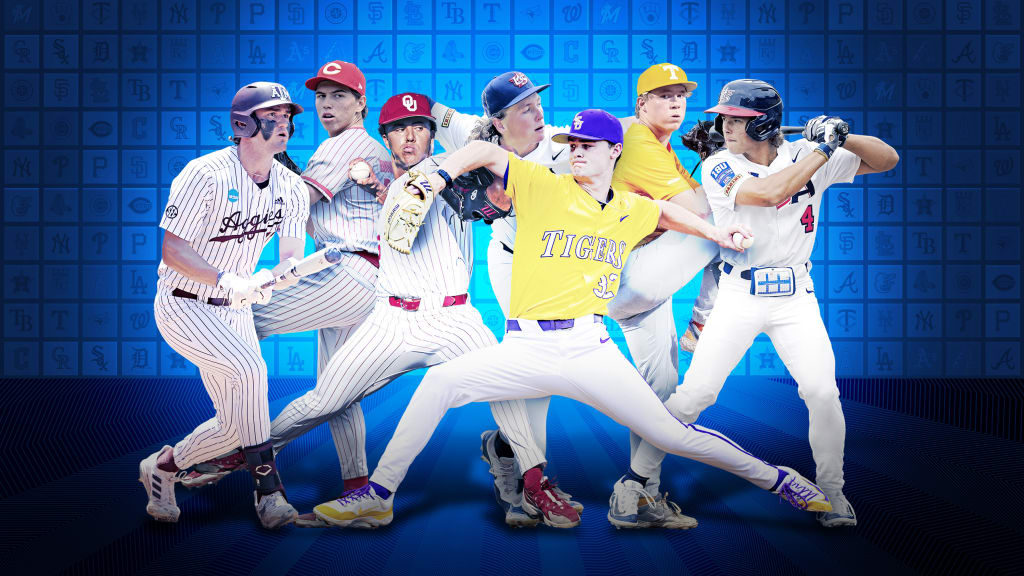
The 2025 Draft saw 615 picks made across 20 rounds over just two days earlier this week.
As we at MLB Pipeline have taken some time to let the dust settle, some picks continue to stand out more than others. It could be that an organization got the best possible talent at their slot, based on the Top 250 rankings. It could be that they got great value for where they were picking. We just might like the fit between player and farm system too.
2025 MLB Draft presented by Nike
Day 1 (Rounds 1-3): Pick-by-pick analysis | Top storylines
Day 2 (Rounds 4-20): Round-by-round analysis
- Best hauls | Biggest steals | Tracker
- Pipeline Podcast analyzes Draft
- Picks with famous family ties
- Corona HS makes Draft history
- Top 250 prospects | Bonus pools & pick values
- Complete coverage
More on the top picks:
1. WSH: Willits | 2. LAA: Bremner | 3. SEA: Anderson | 4. TEX: Holliday | 5. STL: Doyle
6. PIT: Hernandez | 7. MIA: Arquette | 8. TOR: Parker | 9. CIN: Hall | 10. CWS: Carlson
Truth be told, standout selections can come from anywhere in the Draft process. Here are our favorite 2025 picks from each club, including nine from the first round and one as late as the 12th:
Jump to: AL East | AL Central | AL West | NL East | NL Central | NL West
AMERICAN LEAGUE EAST
Blue Jays: JoJo Parker, SS (first round)
Toronto was tied to college pitching for much of the process, which makes sense given the success of 2024 picks Trey Yesavage and Khal Stephen this summer, but went with a potential everyday player at a premium position instead. Parker draws raves for his smooth left-handed swing, and he’s hitting the ball harder as he matures physically. Even if he moves to second or third -- and that conversation will be down the road -- the bat could still make him one of the best picks of the class.
Orioles: Slater de Brun, OF (Round CB-A)
Word on the street was that the Nationals were hoping to get de Brun with their second-round pick at No. 49 overall. The Orioles, with the largest bonus pool among all 30 teams, swooped in and took him at No. 37 overall, getting an outstanding left-handed swinging bat with more pop than you’d expect from a 5-foot-10 outfielder, easy plus speed and defense in a Corbin Carroll kind of way.
Rays: Brendan Summerhill, OF (Round CB-A)
Tampa Bay used the 42nd overall pick to take MLB Pipeline’s No. 16 Draft prospect. The Arizona outfielder faces some questions when it comes to chase rates and overall power, but his bat-to-ball skills, speed and fielding all grade out as above-average as he enters the Tampa Bay system. The Rays may want to keep him in center over right, though he has the arm strength for either.
Red Sox: Kyson Witherspoon, RHP (first round)
The Red Sox planned on targeting pitchers but couldn’t have expected Witherspoon, the best college right-hander, to fall in their laps at No. 15. The Oklahoma star runs his fastball up to 99 mph, owns one of the best curveballs in the Draft and his slider and cutter can be plus offerings as well.
Yankees: Dax Kilby, SS (supplemental first round)
The Yankees had a group of high school hitters they hoped would get to their first pick at No. 39 and estimated they had no better than a 50-50 chance at Kilby. The Newnan (Ga.) HS product was one of the more polished prep bats in the Draft, using a mature approach and quick, compact left-handed swing to make repeated contact from gap to gap.
AMERICAN LEAGUE CENTRAL
Guardians: Jace LaViolette, OF (first round)
LaViolette entered 2025 as the potential first pick in the Draft and wound up as the last choice in the first round, a nice value play for the Guardians. Even though he batted just .258 with a 25.2 percent strikeout rate as a junior, he still offers an impressive combination of raw power, physicality and athleticism and set a Texas A&M career record with 68 homers and 169 walks.
Royals: Josh Hammond, SS/3B (PPI)
Using the pick it acquired for Bobby Witt Jr.’s top three AL MVP finish last year, Kansas City went with Hammond, a North Carolina prep infielder with plus raw power. The Royals pointed out that Hammond is also increasingly showing he can hit against multiple pitch types, and his swing decisions could get even better as he moves away from pitching in the pros. Announced as a shortstop, Hammond might be a better future fit at third base, where his rocket of an arm will be an asset.
Tigers: River Hamilton, RHP (11th round)
In the past, clubs had a night to figure out how much money they could use in Rounds 11-20, when only the overage on bonuses above $150,000 count against the pool. This year, they had an hour break. Detroit seems to believe it can find space for Hamilton, the 99th-ranked player on MLB Pipeline’s Top 250. The Oregon prep right-hander, who has an LSU commitment, is projectable at 6-foot-3, is already up to the mid-90s with his fastball and shows the makings of a solid slider and changeup.
Twins: Matt Barr, RHP (fifth round)
The Twins have a very good history of finding big league arms in the later rounds of the Draft -- Zebby Matthews (8th round), Bailey Ober (12th round), David Festa (13th round) -- and Barr has as much upside as any of those recent examples. The 6-foot-6 junior college product is only 19 years old and throws everything with a ton of spin, from a lively fastball up to 97 mph to two distinct breaking pitches with elite-level spin rates, all coming from a loose and athletic delivery.
White Sox: Jaden Fauske, OF (second round)
It's no secret that the White Sox like to draft players who spent time with their Area Codes Game team, and they grabbed another one in Fauske, who drew supplemental first-round interest from several clubs. Gatorade's Illinois High School Player of the Year after starring at Nazareth Academy (La Grange Park), he's an advanced hitter with a smooth left-handed stroke, a disciplined approach and solid speed.
AMERICAN LEAGUE WEST
Angels: Talon Haley, LHP (12th round)
The Angels love finding a high school arm after the 10th round and signing him, having done so with Caden Dana and Trey Gregory-Alford in recent drafts. Haley is an easy one to root for, having overcome both Tommy John surgery before high school (he learned to throw right-handed so he could play while rehabbing!) and non-Hodgkin lymphoma. He played through chemo and radiation treatments, but then tore his UCL again, needing internal brace surgery. But it’s not just a feel good story of resilience -- he can get his fastball up to 97 mph and has a hammer of a curve, a solid slider and some feel for a changeup.
Astros: Ethan Frey, OF (third round)
Frey played an integral role in Louisiana State's Men's College World Series championship, posting the best batting line (.331/.420/.641) on the team and delivering several clutch hits. He's physically imposing at 6-foot-6 and 225 pounds and patiently waits for pitches that he can drive in the air. He spent much of his college career at DH, in part because he tore the labrum in his right shoulder in 2024, but he's a good athlete with solid speed who was a dual-threat quarterback in high school.
A’s: Devin Taylor, OF (second round)
After being thrilled that Jamie Arnold was there for them at No. 11 overall in the first round, the A’s had another terrific college performer fall in their laps in the second. Taylor has done nothing but rake, with the chance to be a plus hitter with plus power at the next level. He’s likely limited to left field, but who cares with that offensive profile.
Mariners: Kade Anderson, LHP (first round)
Leading up to the Draft, all of the “intel” we were getting is that if Anderson somehow got to the Mariners at No. 3, they would be ecstatic, but it seemed unlikely to happen. Except that it did. It shouldn’t take long for Anderson to join that very solid Mariners big league rotation.
Rangers: A.J. Russell, RHP (second round)
If Russell had been fully healthy this spring, he almost certainly would have gone in the top half of the first round. But he had shoulder and elbow issues in 2024, leading to internal brace surgery that June, and worked just 25 1/3 innings this spring at Tennessee. At his best, Russell has a 92-94 mph fastball that reaches 98 and may have the best heater metrics in the Draft, and a low-80s sweeper that grades as a plus offering.
More from MLB Pipeline:
• Top 100 prospects | Stats | Video | Podcast | Complete coverage
NATIONAL LEAGUE EAST
Braves: Briggs McKenzie, LHP (fourth round)
After drafting bats (one high school, two college) with their first three picks, the Braves may have struck gold in the fourth round with McKenzie, a North Carolina prep lefty who gives off MacKenzie Gore vibes, and not just because of his last name. It’s the feel to spin a curve that draws the comp, even if McKenzie didn’t have the same velocity jump Gore did in high school. There could be more in the tank for this McKenzie, so the side-by-side could become even more accurate.
Marlins: Cam Cannarella, OF (supplemental first round)
Cannarella looked like a slam-dunk Top 10 pick as a Clemson freshman before being hampered by a torn labrum in his right shoulder and the after effects of surgery the next two seasons, so this could be a steal. He still showcased some of the best hitting ability and center-field defense in the college ranks, and he has the plus speed to steal bases despite not running much the last two years.
Mets: Peyton Prescott, RHP (fifth round)
A Draft-eligible sophomore, Prescott moved from Jacksonville to Florida State and struck out 46 in 36 2/3 innings out of the Seminoles' bullpen. He showed a triple-digit heater and got whiffs on a mid-80s slider, but he needed Tommy John surgery after injuring his elbow in Super Regional play. The stuff is good though, and if he can get back to showing it after rehabbing with the Mets, he has upside as a high-leverage relief arm.
Nationals: Landon Harmon, RHP (third round)
Washington found gold in the third round with Travis Sykora in 2023. It went back to the well to take a big, right-handed prep arm who will likely need to sign for above slot here in ‘25. Ranked No. 48 in MLB Pipeline’s Top 250, the 6-foot-5 Harmon earns borderline plus-plus grades for his 93-96 mph fastball because of its flat approach angle. He can manipulate his slider from a sweeper to a cutter look too, and might he just need to find a consistent changeup to take off in the Washington pipeline.
Phillies: Matthew Fisher, RHP (seventh round)
The Phillies went hard after pitching, with nine of their 10 picks in the bonus pool range (top 10 rounds) being arms. Only one came from the high school ranks and that was Fisher, a super-projectable and athletic right-hander who was also his high school quarterback. We constantly point out that if players are drafted in the top 10 rounds, they are 99.9 percent certain to sign, but it’s not common to see an over-slot high school player at this stage in a Draft.
NATIONAL LEAGUE CENTRAL
Brewers: Daniel Dickinson, 2B/SS (sixth round)
Dickinson was a two-year standout at Utah Valley, made the U.S. collegiate national team, transferred to LSU and helped the Tigers win the Men’s College World Series last month. That whirlwind career has been pushed by the right-handed hitter’s innate hand-eye coordination, and while he faces plenty of questions about his pop (especially with wood bats), Dickinson could make a jump with Brewers hitting instructors that routinely get the most out of young bats. Announced as a shortstop, he’s a better fit at second base due to average arm strength.
Cardinals: Liam Doyle, LHP (first round)
With the fifth overall pick, the Cardinals got the most explosive pitcher in this year’s class. Doyle’s fastball picked up some velo into the mid-90s (touching 100) this spring, and the carry out of a high arm slot makes it play up even more. The Tennessee star has three more above-average offerings in his slider, cutter and splitter too, and while some wonder how he can hold his high-octane style over a full pro season, his stuff may be so good that he’ll need to be challenged with quick moves up the chain toward St. Louis.
Cubs: Ethan Conrad, OF (first round)
Though Conrad played just 21 games at Wake Forest this spring before injuring his left shoulder diving for a ball in March and having season-ending surgery, his skills were apparent. He starred at Marist and in the Cape Cod League in 2024, and he continued to make hard contact while showcasing solid speed and playing a capable center field.
Pirates: Seth Hernandez, RHP (first round)
For the second year in a row, the Pirates had the chance to take a high school player who could end up being the best player in the Draft. Last year, concerns about his hit tool allowed Konnor Griffin to get to them at No. 9, and we’ve seen how that’s turned out. This year, they didn’t pass on the chance to take by far the best high school pitcher in the class in Hernandez, whose polish and pure stuff could allow him to move faster than most prep arms.
Reds: Mason Neville, OF (fourth round)
We were surprised that Neville, who tied for the NCAA Division I lead in home runs (26) this spring, lasted until the fourth round, and it sounds like the Reds were, too. Yes, there are some swing/miss and platoon split concerns, but the power is legit and he has the chance to play center field, so this could be a steal in the fourth.
NATIONAL LEAGUE WEST
D-backs: Dean Livingston, RHP (fourth round)
This one’s all about projection. Livingston didn’t join his Georgia high school rotation until this spring, so he still has plenty of experience to pick up in the Arizona system. Scouts were already projecting that the 6-foot-4 righty could some day hit triple-digits given that he already touches 96. His changeup is ahead of his slider and curveball, and the D-backs may want him to focus on one breaking ball early in his career. That combination of size, current velocity and expected improvements isn’t often available in the fourth.
Dodgers: Cam Leiter, RHP (second round)
Leiter made only seven starts at Florida State in 2024 before coming down with shoulder problems that cost him all of this season, though he did throw a bullpen workout for clubs shortly before the Draft. He would have been an easy first-round pick without health issues, and he's the type of gamble a wildly successful organization like the Dodgers can afford to take. His fastball sits at 95 mph and touches 98 while exploding on hitters, his upper-80s slider can be a wipeout pitch and he shows feel for a curveball and changeup as well.
Giants: Cameron Maldonado, OF (seventh round)
Maldonado slashed .351/.467/.631 with 15 homers and 29 steals while displaying an interesting mix of tools at Northeastern this spring. He does come with some swing-and-miss concerns that knocked him down to the seventh round, but he's also a center fielder with plus raw power and speed who set a Huskies record with 86 career steals.
Padres: Kruz Schoolcraft, LHP (first round)
San Diego only has $6,569,100 in its pool this year, the third-lowest of any organization, and could have been forgiven for not taking a big swing at No. 25 overall in order to spread out that pool. Instead, they went big on Schoolcraft, who could end up being one of the most talented arms in the whole class. Standing 6-foot-8, the southpaw has three above-average pitches in his fastball, slider and changeup, and he could take off now that he’s set to be a full-time pitcher. It’s the ninth straight year the Padres have gone the high school route in the first round.
Rockies: Ethan Holliday, SS (first round)
It’s a cause for celebration when you can get the player most felt was the best talent in the class, especially when you weren’t sure he’d get there, as he was in very strong contention to go No. 1 overall. Whether he ends up at short or moves to third, it doesn’t really matter because his bat has the chance to be very special.


